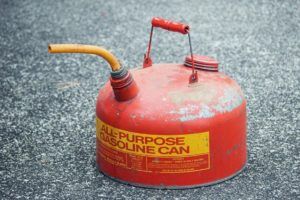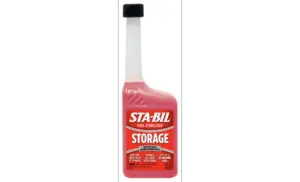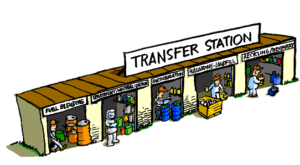We all buy gasoline with the best of intentions — to power that lawnmower, weed wacker, or old boat. Unfortunately, you didn’t make use of it and now you’re looking to get rid of the old gasoline. It is not as easy as just dumping it out (at least it should not be….)
In this guide, we’ll teach you the four steps to get rid of your old gasoline.
- Verify that your gasoline is in fact old
- Filter your old gas and mix it with new gas
- Contact automotive shops in your area
- Contact and visit a local recycling or disposal facility
Why you need to properly get rid of old gasoline
It’s important to understand why you need to properly get rid of old gasoline. Gasoline is a refined product that is made up of very distinct chemicals and characteristics. To put it simply, gasoline will start to degrade over time which causes it to ineffectively burn in your equipment or vehicle’s engine. Most gasoline today is made with an ethanol blend, and that ethanol turns to water over  time. Water in the gas is not good for any engine.
time. Water in the gas is not good for any engine.
What makes this dangerous is the fact that your vehicle may still run on old gasoline. Having gasoline that burns ineffectively in your equipment or vehicle’s engine will not only damage the asset, but it will also cause oxidation.
Oxidation in simple terms is a buildup of gunk that will clog gas lines, filters, and small orifices. If you continue to use your equipment or drive your vehicle with old gasoline, it will start to run poorly over time. Having to remove oxidation is very expensive, so it’s best to avoid using old gasoline entirely. In short, if you have gas that is more than 5-6 months old, you may want to considering throwing it out. After 12 to 24 months, it most likely is not good anymore.
And you can’t just dump it out. Not only is that illegal, but the gasoline is likely to kill whatever grass, trees, or other vegetation it comes in contact with.
Before going any further, please know that handling gasoline can be dangerous. It is extremely flammable and the fumes and liquid itself are harmful to one’s health.
Step 1. Verify that your gasoline is in fact old
Before you dispose of your gas, it’s important to verify that it’s old. You don’t want to waste perfectly good gasoline as the price per gallon can be quite expensive. To verify whether your gasoline is old or not, do a quick examination:
- Check if the gas has gotten dark. As we mentioned earlier, old gasoline oxidizes. This will cause the color of the gas to darken over time.
- Look for a sour odor. Quickly smell your gas to see if there’s a sour or rotten odor to it. This is another cause of oxidized gas.
- Think about when you stored your gas. It takes gasoline around three to six months to go bad. However, preserving your gas near the six-month point requires proper storage. If you simply stored gas at the back of your shed for over six months, your gas most likely degraded.
- Compare your gas with fresh gas. A simple way to check whether your gas is old or not is comparing it with fresh gas. Grab two transparent glass containers and pour fresh gas into one,
 and your stored gas in the other. If there is an obvious distinction between the two, your stored gas is most likely old.
and your stored gas in the other. If there is an obvious distinction between the two, your stored gas is most likely old.
The gas probably stayed good longer if it was stored in a sealed, gas-safe container, or treated with a fuel additive. For future reference, here are the products we are talking about:
- A CARB-compliant container made specifically for gasoline, like this one on Amazon.
- Fuel additive, that can extend the life of stored gasoline. We swear by Sta-Bil, and find it extends the life of gas by many months. Find it here on Amazon.
If you find that your old gasoline is slightly different from new gas, you can actually reuse some gas by filtering it out and mixing it with new gas. This is what we’ll teach you to do in the next step. However, if your gas is dark and has a bad smell to it, skip to step three of this guide.
Step 2. Filter your old gas and mix it with new gas
If you found that your old gas looks almost like new gas, it means you can recondition the gas and reuse some parts of it. Doing so will save you some money from purchasing more gas or disposing all your old gas to a disposal facility.
- Grab a glass container that’s large enough to hold all your gas.
- Use a funnel and place it into the opening of your glass container. This is going to help pour all the gasoline directly into the glass.
- Place a filter such as a coffee filter or use two pieces of thin cloth inside your funnel. This is going to help catch debris and other particles.
- Slowly pour your old gasoline into the funnel until all of it has been filtered.
And there you have it. You now have filtered gasoline that is more likely to work well when mixed with new gas. As a rule of thumb for mixing old gas with new gas, always keep the ratio at 1:5. For example, if you have 1 litres or 0.26 gallons of old gas, you should mix it with at least 5 litres or 1.3 gallons of new gas.
What you are doing is diluting the old gas, so that any imperfections or water content will be less prominent when cycling through your engine.
Remember, using filtered gas may not run like new gas. You will find that it’ll burn slightly less efficient, but it still works. The engine may sputter a bit or smoke, but at least you are burning the gas rather than dumping it.
Step 3. Contact automotive shops in your area
The next step is to contact automotive shops in your area. These shops are usually willing to take in hazardous liquids, including old gasoline. Automotive shops are your best option because they will either charge you a small fee or even take your old gas for free.
If you’ve never disposed of old gas before, be advised that it can be very expensive. Nobody is sitting around clamoring for old gas — it is a burden. That’s why it’s best you contact all the local automotive shops in your area. If for some reason they’re all unwilling to take your old gas off your hands, you may have to visit and pay for a disposal service at a recycling or disposal facility.
If an automotive shop is willing to take your old gasoline in, ask them for clear instructions on how you should deliver the gas. In most cases, you’ll have to transfer your old gas into an approved and airtight container. Usually, plastic and metal cans designed to store gas should be fine. Always double check that your containers are sealed tight before setting them in your car. Also, set them in a bin that’ll prevent your gas from falling over.
It’s incredibly important to prevent any gas from spilling out the containers as this can lead to a fire, or cause damage to your skin. If some gasoline has spilled on you, wash it off immediately before it causes any damages.
Step 4. Contact and visit a local recycling or disposal facility
If you had no luck finding an automotive shop that is willing to take your old gasoline in, search online for the nearest recycling or disposal facility to get rid of your old gasoline. Every facility may  have different instructions for you to follow, so it’s best to contact them beforehand. Ask for clear instructions and then prepare accordingly.
have different instructions for you to follow, so it’s best to contact them beforehand. Ask for clear instructions and then prepare accordingly.
Many cities or counties have a station specifically designed for accepting old, hazardous chemicals like gasoline. Google for “hazardous waste drop-off near me”.
It is important to ask what type of gas they will accept. Some facilities have to follow strict guidelines when handling old gasoline, therefore, they might not be able to dispose of yours.
Once you’ve contacted a place to dispose of your old gas, prepare your gas using the same transfer method in step three and bring your gas to the facility. Keep in mind that some disposal facilities may charge you a fee when disposing gas. Depending on their services, these fees can get pretty expensive.
Be careful if transporting gas inside a vehicle. The vapors can use light-headedness and dizziness even if none spills. Best to haul it in a pick-up truck or on a trailer.
If you have a large volume of old gasoline to dispose of, it may be cheaper for you to contact a private disposal company in your area. Although you’ll still have to pay a relatively expensive fee, it’s most likely going to be cheaper than visiting a government official disposal facility.